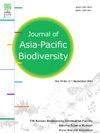Diversity and habitat utilization of terrestrial gastropods in Lava, West Bengal, India, with particular emphasis on Deroceras laeve distribution
IF 0.7
Q4 BIODIVERSITY CONSERVATION
引用次数: 0
Abstract
The eastern Himalayas comprise an extensive malacofauna diversity, but most of the earlier studies are based on taxonomy and little consideration was given to their ecology. In this context, the diversity, habitat utilization, and microhabitat preference of terrestrial gastropods occurring in Lava, India, were assessed in this study. As an extension, the season-wise availability of the non-native slug, Deroceras laeve, was evaluated along with the estimation of suitable habitats of D. laeve in the Darjeeling Himalayas under the current and future climates using species distribution modeling. During the survey, 5033 individuals belonging to 13 gastropod species were encountered, and Cryptaustenia heteroconcha was the most abundant gastropod, followed by Macrochlamys sp. and D. laeve. Macrochlamys sp. and Kaliella sp. were the most generalist and specialized species regarding microhabitat utilization. D. laeve and C. heteroconcha were mostly found on ornamental plants and crops, respectively. The abundance of D. laeve and its eggs was greater during the monsoon season than in the other seasons. The results of species distribution modeling identified discrete regions of the Darjeeling Himalayas with high and moderate suitability for D. laeve occurrence, which may reduce with climate change. The present observations may help to frame conservation (of native gastropods) and management (of pestiferous gastropods) strategies through the identification of microhabitat preferences and suitable habitats.
印度西孟加拉邦熔岩陆生腹足类动物的多样性和生境利用,重点研究了其叶片分布
东喜马拉雅地区拥有广泛的马拉科动物多样性,但大多数早期的研究都是基于分类学,很少考虑它们的生态学。在此背景下,本研究评估了印度熔岩陆生腹足类动物的多样性、栖息地利用和微生境偏好。在此基础上,利用物种分布模型分析了当前和未来气候条件下大吉岭地区非本地蛞蝓(Deroceras laeve)的季节可得性,并对其适宜生境进行了估算。调查共捕获腹足动物13种5033只,其中异孔隐足动物(Cryptaustenia heteroconcha)数量最多,其次为Macrochlamys sp.和D. laeve。Macrochlamys sp.和Kaliella sp.是微生境利用最通用化和特化的物种。金针叶和金针叶分别主要分布在观赏植物和农作物上。在季风季节,白蛉及其卵的丰度高于其他季节。物种分布模拟结果表明,在大吉岭-喜马拉雅山脉的离散区域,白杨的适宜度可能随气候变化而降低。目前的观察结果可能有助于通过确定微栖息地偏好和适宜栖息地来制定保护(本地腹足动物)和管理(鼠疫腹足动物)的策略。
本文章由计算机程序翻译,如有差异,请以英文原文为准。
求助全文
约1分钟内获得全文
求助全文
来源期刊

Journal of Asia-Pacific Biodiversity
Agricultural and Biological Sciences-Insect Science
CiteScore
1.70
自引率
12.50%
发文量
94
审稿时长
27 days
期刊介绍:
The Journal of Asia-Pacific Biodiversity (previous title was Journal of Korean Nature) is an official journal of National Science Museum of Korea (NSMK) and Korea National Arboretum (KNA). The scope of journal is wide and multidisciplinary that publishes original research papers, review articles, as well as conceptual, technical and methodological papers on all aspects of biological diversity-its description, analysis and conservation, and its application by humankind. This wide and multidisciplinary journal aims to provide both scientists and practitioners in conservation theory, policy and management with comprehensive and applicable information. However, papers should not be submitted that deal with microorganisms, except in invited paper. Articles that are focused on the social and economical aspects of biodiversity will be normally not accepted.
 求助内容:
求助内容: 应助结果提醒方式:
应助结果提醒方式:


